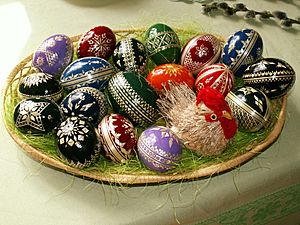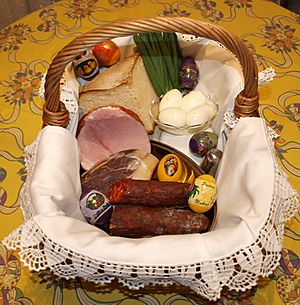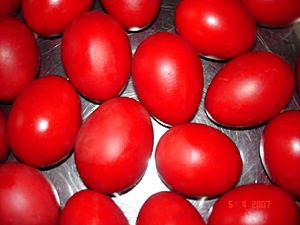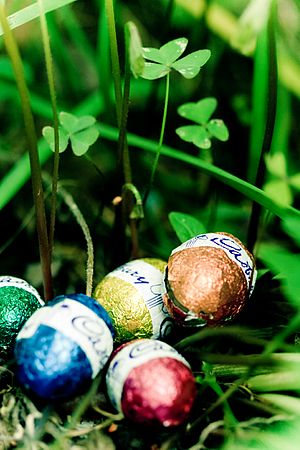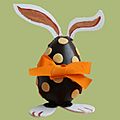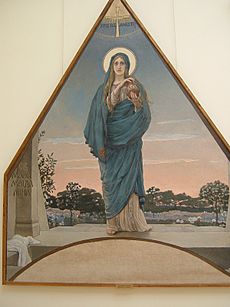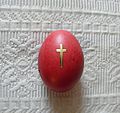Easter egg facts for kids
An Easter egg is a special egg that people eat and use to decorate their homes during the Easter holidays. For a long time, eggs have been a symbol of new life and spring. Early Christians saw the egg as a sign of Jesus's resurrection (meaning His rising from the dead).
Contents
What is the History of Easter Eggs?
Some people think Easter eggs came from older, non-Christian traditions, but there isn't strong proof for this. In ancient times, many cultures, like the Egyptians, Persians, and Romans, used eggs in their spring celebrations. This was because eggs were seen as symbols of new life and fertility.
In Christian history, the egg became a symbol of new life, much like a chick hatching from an egg. The tradition of Easter eggs might also have grown from the end of Lent. Lent is a time when some Christians fast (give up certain foods). In the past, people in Medieval Europe were not allowed to eat eggs on fast days. So, they would use up all their eggs before Lent began, which led to the tradition of Pancake Day!
Eggs were given as gifts to children and servants, and they were used for decorating. This is probably why eggs became so connected with Easter.
How are Easter Eggs Decorated and What Do They Mean?
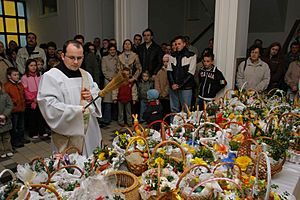
Why are Eggs Important During Lent?
The tradition of Easter eggs also connects to the end of Lent in Western Christianity. Historically, people would use up all their eggs before Lent started. This is because eggs were often forbidden during Lent, as well as on other traditional fast days. This rule still exists in some Eastern Christian Churches today.
This is why Shrove Tuesday (also called Mardi Gras or "Fat Tuesday") is celebrated. It's the day before Lent begins, and it's a last chance to eat eggs and dairy products before the fasting period.
During Lent, chickens still lay eggs! So, by the end of the fast, families would have many eggs. These eggs needed to be eaten quickly so they wouldn't spoil. When Easter arrived, people would start eating eggs again. Some families even cook special dishes with eggs for their Easter dinner.
What Do Easter Eggs Symbolize?
For many Christians, the cracking open of an Easter egg reminds them of Jesus's empty tomb. It's like new life breaking out.
In Orthodox churches, priests bless Easter eggs at the end of the Easter Vigil. These eggs are then given to the people. The egg is a symbol of resurrection: it looks like it's sleeping, but it holds new life inside.
In Poland, a tradition called święconka involves blessing decorative baskets filled with Easter eggs and other symbolic foods on Holy Saturday.
In Greece, women traditionally dye eggs red using onion skins and vinegar on Thursday before Easter. These special eggs are called kokkina avga. Red Easter eggs are sometimes placed on a braided loaf of bread called tsoureki.
In Egypt, people decorate boiled eggs during the Sham el-Nessim holiday, which happens after Eastern Christian Easter.
How are Easter Eggs Coloured?

Dyeing Easter eggs in different colours is very common. People can use natural things like onion peel (for brown), oak bark (for black), or beet juice (for pink). They can also use artificial colours.
In the North of England, these dyed eggs are called pace-eggs or paste-eggs. People often eat them after an egg-tapping competition.
In Orthodox and Eastern Catholic Churches, Easter eggs are dyed red. This colour represents the blood of Christ. The hard shell of the egg also symbolizes the sealed Tomb of Christ, and its cracking represents His resurrection.
How are Patterns Made on Easter Eggs?
When boiling eggs with onion skins, you can attach leaves to the eggs before dyeing them. Wrap the eggs tightly with a thin cloth like nylon stockings. After dyeing, remove the leaves, and you'll see beautiful leaf patterns! These patterned eggs are part of Easter customs in many places.
Pysanky are Ukrainian Easter eggs decorated using a special wax-resist method, like batik. The word pysanky comes from the word "to write," because the designs are "written" onto the egg with beeswax, not painted. This method of decorating eggs with wax is popular in other Eastern European countries too.
How are Easter Eggs Used in Decorations?
In some Mediterranean countries, like Lebanon, boiled eggs are decorated with dye or paint and used as house decorations. On Easter Day, children play a game where they hit each other's eggs, saying "Christ is resurrected, Indeed, He is!" The eggs break, and then they eat them. This game is also played in Bulgaria, Cyprus, Greece, Macedonia, Romania, Russia, Serbia, and Ukraine. The person whose egg doesn't break is thought to have good luck in the future.
In Germany, people decorate trees and bushes with eggs, creating Easter egg trees. They also decorate public wells, calling them Osterbrunnen.
In Ukraine, it used to be a custom during Easter to place krashanky (dyed eggs) in a bowl with wheatgrass on the table. The number of eggs would match the number of family members who had passed away.
Easter Egg Games
Egg Hunts
An egg hunt is a fun game where decorated eggs are hidden for children to find. These can be real hard-boiled eggs or artificial ones filled with chocolate candies. The eggs are hidden indoors or outdoors. After the hunt, prizes might be given for finding the most eggs, or for the biggest or smallest egg.
In Central European Slavic countries, like the Czechs and Slovaks, there's a tradition where boys visit girls' homes. They gently whip the girls with a whip made of fresh willow branches and splash them with water. This is believed to bring health and beauty. In return, the girls give them eggs.
Cascarones are a Latin American tradition, now popular in many US states with Hispanic communities. These are empty, dried chicken eggs filled with confetti and sealed with tissue paper. They are hidden like Easter eggs, and when found, children (and adults!) break them over each other's heads.
To help children with visual impairment join egg hunts, special eggs have been made that make sounds like clicks, beeps, or music. This helps them find the eggs easily.
Egg Rolling
Egg rolling is another traditional Easter egg game. In the United Kingdom, Germany, and other countries, children traditionally roll eggs down hillsides at Easter. This tradition came to the New World with European settlers. Today, an Easter egg roll is held every Easter on the White House lawn in the United States. Different countries have their own versions of this game.
Egg Tapping
In the North of England, during Easter, a game called "egg tapping" or "egg jarping" is played. Players each have a hard-boiled egg. They hit each other's eggs with their own. The winner is the person whose egg is the last one to stay intact. The annual egg jarping world championship is held every year in Peterlee Cricket Club.
This game is also played in Italy, Bulgaria, Hungary, Croatia, Latvia, Lithuania, Lebanon, Macedonia, Romania, Serbia, Ukraine, Russia, and other countries. In Greece, it's called tsougrisma. In South Louisiana, it's called "pocking eggs," and the winner gets to eat the loser's egg!
In the Greek Orthodox tradition, red eggs are also tapped together when people exchange Easter greetings.
Egg Dance
An Egg dance is a traditional Easter game from Germany. Eggs are placed on the ground, and the goal is to dance among them without breaking any. In the UK, this dance is called the "hop-egg."
Pace Egg Plays
The Pace Egg plays are traditional village plays performed in England during Easter. They tell a story about rebirth. The play usually involves a fight between a hero and a villain, where the hero is killed but then brought back to life.
Different Kinds of Easter Eggs
Chocolate Eggs
In 1873, J. S. Fry & Sons in England made the first chocolate Easter egg.
Today, giving chocolate eggs is very common in Western countries. For example, over 80 million Easter eggs are sold in the UK alone!
-
Gladys as a Chocolate Easter Bunny with Easter eggs
Marzipan Eggs
In the Indian state of Goa, a sweet treat called Marzipan is used to make Easter eggs. In the Philippines, a type of marzipan called mazapán de pili is made from pili nuts.
Artificial Eggs
The jewelled Easter eggs made by the Fabergé company for the last two Russian Tsars are considered amazing works of art. Many of these beautiful eggs had hidden surprises inside, like tiny clock-work birds or miniature ships.
In Bulgaria, Poland, Romania, Russia, Ukraine, and other Central European countries, it's common to make artificial eggs out of porcelain for decoration.
Easter eggs are also shown in sculptures. For example, there's a 27-foot (9 meter) sculpture of a pysanka (Ukrainian Easter egg) in Vegreville, Alberta, Canada.
-
Giant Easter egg, Bariloche, Argentina
-
Giant pysanka from Vegreville, Alberta, Canada
Legends About Easter Eggs
Christian Stories
One legend in Eastern Christianity says that Mary Magdalene was bringing cooked eggs to share with other women at Jesus's tomb. When she saw the risen Christ, the eggs in her basket miraculously turned bright red!
Another story about Mary Magdalene says that after Jesus went to heaven, she went to the Emperor of Rome. She greeted him with "Christ has risen!" The Emperor pointed to an egg on his table and said, "Christ has no more risen than that egg is red." Right after he said this, the egg immediately turned blood red.
Red Easter eggs, known as kokkina avga in Greece and krashanky in Ukraine, are a strong Easter tradition. They represent the blood of Christ shed on the cross. This practice dates back to the early Christian church. In Greece, people used to believe that placing the first-dyed red egg at their home's icon display would keep evil away. They also marked the heads and backs of small lambs with red dye to protect them.
Similarities in Other Beliefs
The egg is widely used as a symbol of new beginnings, just like new life comes from an egg when a chick hatches.
Painted eggs are used in Iranian spring holidays, called Nowruz. This holiday marks the first day of spring and the start of the new year in the Persian calendar. Painted eggs symbolize fertility and are displayed on the Nowruz table, called Haft-Seen. Sometimes there's one egg for each family member. This tradition has existed for at least 2,500 years.
The Neo-Pagan holiday of Ostara happens around the same time as Easter. While some claim that painted eggs were part of ancient Ostara celebrations, there isn't much historical proof for this. It's more likely that the use of painted eggs was adopted later, thinking it might be an old tradition.
There's also a connection between hares (which later became Easter bunnies) and eggs. This comes from old stories that confused where hares raise their young with where plovers (a type of bird) build their nests.
In Judaism, a hard-boiled egg is part of the Passover Seder meal (which happens around the same time as Christian Holy Week). It represents a festival sacrifice. The children's game of hunting for the afikomen (a hidden piece of matzo bread) is similar to the Easter egg hunt. The child who finds the hidden bread usually gets a prize.
Images for kids
-
Red-coloured Easter egg with Christian cross, from the Saint Kosmas Aitolos Greek Orthodox Monastery
-
Eggs at the Iranian Nowruz
-
Easter eggs from Sorbs
-
Easter egg from Poland
-
Kinder Surprise Egg, manufactured by Italian company Ferrero SpA
-
Giant Easter egg in Suceava, Romania
See also
 In Spanish: Huevo de Pascua para niños
In Spanish: Huevo de Pascua para niños


